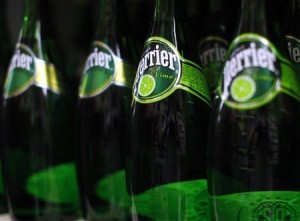By Martinne Geller
NEW YORK (Reuters) - At New York’s Del Posto, diners can share a $130 entree of wild branzino fish with roasted fennel and peperonata concentrato and a $3,600 bottle of Dom Perignon. They cannot share a bottle of Perrier or San Pellegrino water.
The Italian restaurant backed by celebrities Mario Batali and Joseph Bastianich is one of several shunning bottled water, along with the city of San Francisco and New York state.
“The argument for local water is compelling and obvious,” said Bastianich, who is phasing out bottled water across his restaurant empire, which stretches to Los Angeles.
“It’s about transportation, packaging, the absurdity of moving water all over the world,” he said.
As environmental worries cut into sales from traditionally lucrative bottled water, beverage companies such as Coca-Cola, PepsiCo, Nestle and SABMiller are becoming more attuned to the risks of negative consumer environmental perceptions.
Water is becoming scarcer, raising a fear that so-far manageable price increases could spike and leading drink companies to take action to maintain access to water and fight their image as water hogs.
“Water is the new oil,” said Steve Dixon, who manages the Global Beverage Fund at Arnhold & S. Bleichroeder, repeating what has become a mantra as climate change and population growth tax water supplies.
“As an investor, I’m not concerned about the reality,” Dixon said, guessing there will always be enough water overall. “But I’m aware of the perceptions … and you can’t totally shrug it off because perceptions are important.”
About a third of the world’s people now live in areas of water stress, said Brooke Barton, manager of corporate accountability for Ceres, a network of environmental groups and investors seeking to address sustainability challenges. By 2025, she said it will be more like two-thirds.
COST
Water is still cheap, but that is changing.
“(Water) is currently not a very big cost. The issue is where it will it go in the future,” said Andy Wales, head of sustainable development for brewer SABMiller, which used 94.5 billion liters of water in its latest fiscal year. That works out to 4.5 liters for every liter of beer it made.
Water and energy combined only made up 5 percent of its costs, overshadowed by brewing ingredients, bottling materials and labor. Still the brewer said water costs at a Bogota, Colombia plant are rising some 12 percent a year from increased soil being washed into the river as cattle grazing upstream causes deforestation.
New water pricing schemes are emerging, such as the European Union’s Water Framework Directive that will tax water from 2010 to encourage more sustainable use.
Some 70 percent of the water the world uses is for agriculture, while industry uses 20 percent. But any industry reliant on agriculture — from meat to jeans — has more to wade through than its own use.
SABMiller is one of a few companies, including Coke and Pepsi, calculating “water footprints.” It found that water used throughout its supply chain, such as to grow barley and hops, can be 34 times more than its use alone.
With 139 breweries on six continents, the brewer’s total water use can range from about 40 liters for a liter of beer in Central Europe to 155 liters in South Africa. Using the smaller ratio as a proxy, SABMiller’s entire “water footprint” was roughly 8.4 trillion liters of water last year, more than double what the small nation of Iceland used in 2004.
“In the long term we do see it as a risk,” Wales said.
REPUTATION
As they face criticism, multinational drink companies are setting water conservation targets, building community wells and more efficient factories, working with locals on sustainable farming, water harvesting and reforestation and looking for new technologies to reduce their water consumption even as they make more drinks.
“For our type of business, or any that have a very direct link to water … We’ve got to play that role,” said Greg Koch, Coke’s managing director of global water stewardship.
Within their own walls, nonalcoholic drink makers use one out of every 3,300 gallons, or 0.03 percent, of the groundwater used in the United States, according to the American Beverage Association. But its symbolism as a visible user puts the sector at the forefront of the fight over water resources, said Kim Jeffery, chief executive of Nestle Waters North America.
“Picking on our industry is like a gnat on the elephant,” said Jeffery, whose 2003 contract to build a bottling plant in McCloud, California has been derailed by opposition from residents and groups concerned about the environmental impact and the threat of water privatization.
Nestle just began a 3-year study of the area’s resources, but Jeffery said there is a good chance the project will never happen, due to changing economics and cold feet on both sides.
“At the end of the day, if they don’t want us there, we won’t be there,” he said.
Tom Pirko, president of consulting firm Bevmark LLC, said it is key for companies to act in line with consumers’ mindsets on such issues, since it is hard in such a crowded marketplace to regain support once it evaporates.
Coca-Cola learned that the hard way, after a drought in the Indian state of Kerala led to the closure of its bottling plant there amid criticism that it was sucking the water table dry.
Coke said its plant did not fuel the shortages, but an outcry still spread across the globe, with students in Britain and North America urging boycotts. Massachusetts’ Smith College even severed a five-decade relationship with the company by refusing to let it bid for its soft drink contract.
“What we lost there was the social license to operate,” Koch said. Environmental and community groups are still fighting to kick Coke out of other villages in India.
“When the consumer turns against you, you’re dead,” Pirko said.
(Reporting by Martinne Geller; Editing by Cynthia Osterman)

